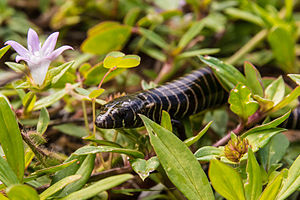Double tongue creep
| Double tongue creep | ||||||||||||
|---|---|---|---|---|---|---|---|---|---|---|---|---|

Diploglossus lessonae |
||||||||||||
| Systematics | ||||||||||||
|
||||||||||||
| Scientific name | ||||||||||||
| Diploglossidae | ||||||||||||
| Boucourt , 1873 |
The double-tongued creeps (Diploglossidae) are a family of the creepers (Anguimorpha) living in Mexico , Central America , western Colombia , on the Brazilian Atlantic coast and in the basin of the Río de la Plata and its tributaries .
features
They are generally small lizards that have small but well-developed legs. The tail is long and autotome . A side fold is usually missing. The frontal bone is paired. In the lower jaw one always counts more than 15 teeth, the rear ones are two-pointed. Palatine teeth are missing. The scales in front of the parietal bone are small. The smallest double- tongued sneak species reaches a length of 6 cm ( Celestus macrotus ), the largest ( Celestus anelpistus ) becomes 28 cm long.
Way of life
Double-tongue sneaks occur mainly in forests, some species also in bushland or dry grassland. They live terrestrially (on the ground) or dig and are mostly nocturnal or crepuscular. Their diet consists mainly of arthropods and other invertebrates .
Within the double-tongue creeps there are both oviparous (egg-laying) and viviparous (live-bearing) species. The clutch size or the number of newly born young depends on the size of the species and is between two and 27.
Systematics
There are three genera belonging to the double-tongue creeps:
The double-tongue sneaks were until recently a subfamily of the sneaks (Anguidae). Since, according to various phylogenetic studies, they are the sister group of a clade of sneaks and ringlets (Anniellidae), both taxa in the family, they have recently also been viewed as an independent family.
literature
- Laurie J. Vitt, Janalee P. Caldwell: Herpetology. An Introductory Biology of Amphibians and Reptiles . 4th edition. Academic Press, Amsterdam 2014, ISBN 978-0-12-386920-3 .
Individual evidence
- ↑ Robert Alexander Pyron, Frank T. Burbrink, John J. Wiens: A phylogeny and revised classification of Squamata, including 4161 species of lizards and snakes. In: BMC Evolutionary Biology. Vol. 13, 2013, 93, doi : 10.1186 / 1471-2148-13-93 .
- ↑ Zheng, Yuchi; John J. Wiens: Combining phylogenomic and supermatrix approaches, and a time-calibrated phylogeny for squamate reptiles (lizards and snakes) based on 52 genes and 4162 species. Molecular Phylogenetics and Evolution, 2016, 94: 537-547, doi: 10.1016 / j.ympev.2015.10.009


